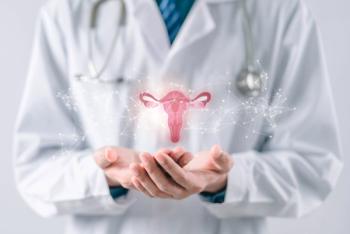
Subjective and Objective Outcomes of Botulinum Toxin Type A Treatment in Vestibulodynia
Botulinum toxin type A may be effective in reducing coital pain in vestibulodynia with levator ani tenderness, but has little effect on vestibular allodynia.
Synopsis
Botulinum toxin type A may be effective in reducing coital pain in vestibulodynia with levator ani tenderness, but has little effect on vestibular allodynia.
Objectives
To collect pilot data on the efficacy of intramuscular botulinum toxin type A (BTX/A) injection into the levator ani muscles to relieve coital pain, reduce pelvic floor tension and instability, and reduce vestibular hyperalgesia in vestibulodynia.
Study Design
Two subjects meeting diagnostic criteria for vestibulodynia were treated with 20 u and 40 u of BTX/A at 12-week intervals. Outcomes included a visual analogue scale (VAS), weekly coital pain diaries, surface electromyography (sEMG), and a vulvar algesiometer.
Results
BTX/A modestly reduced coital pain in one patient and was ineffective in the other. Pelvic floor hypertonicity and variability were markedly reduced in both patients, but negligible changes occurred in vestibular hyperalgesia. The patient with greater pelvic floor tension had more reduction in diary-rated coital pain at 2 weeks post injection (29% v. 9%) and on the VAS at 12 weeks (15% vs. 3%).
Conclusion
BTX/A injections may be effective in reducing coital pain in vestibulodynia with levator ani tenderness, but has little effect on vestibular allodynia. The relationship between pelvic floor hypertonicity and decreased coital pain suggests vestibulodynia may be a variant of Chronic Regional Pain Syndrome. Dose and volume of BTX/A injected may be related to degree of relief.
Vulvodynia is a complex disorder characterized by vulvar discomfort. Its classification is based on the pain’s location, whether it is generalized or localized, and whether it is provoked, unprovoked, or mixed.1 Provoked vestibulodynia, formerly known as vulvar vestibulitis syndrome (VVS), refers to discomfort from intercourse, clothing pressure, tampon insertion, or cotton-tipped applicator pressure on pelvic examination.
Although its etiology is unknown, vestibulodynia may be a variant of a chronic pain condition known as Complex Regional Pain Syndrome (CRPS). Complex Regional Pain Syndromes are painful conditions that usually affect the extremities and consist of a broad spectrum of sensory, autonomic, and motor features subdivided into two types. Type I occurs in the absence of any identified peripheral nerve injury whereas Type II occurs in association with a known peripheral nerve injury.2 Because vestibulodynia often occurs without an identifiable cause or a proven neurological injury, it is more likely to resemble Type I CRPS. However, one case report attributed equestrian dyspareunia to local pelvic trauma.3
In CRPS, hypertonic pelvic floor muscles initiate a process by which local visceral afferent nerve fibers release histamine and prostaglandins. The resulting inflammation produces irritation of the vulvar tissue. This results in tissue tenderness and leads to further reflex spasms of the pelvic muscle resulting in positive feedback that exacerbates the condition. Two reports have demonstrated that biofeedback-induced pelvic muscle relaxation is associated with reduced vestibular pain in women with vestibulodynia.4,5 These data support the hypothesis that hypertonic and unstable muscles in the pelvic floor are a contributing factor in perpetuating vulvar pain. Therefore, other interventions that would reduce muscle tone may also be an effective treatment for this condition.
Botulinum toxin type A (BTX/A) inhibits release of acetylcholine from the presynaptic region of the neuromuscular junction, producing chemodenervation that results in reduced muscle tone.6-8 Thus, BTX/A would break the cycle of hypertonic and unstable pelvic floor muscles stimulating nerve conduction and further spasm. Three case reports and one open-label study have reported reduced coital pain following BTX/A injection. 9-12 BTX/A doses varying from 10-80 u produced pain relief in 2-14 days and lasted from 3-36 months. Vestibular pain was associated with levator ani tenderness in two of the case reports and in the open label study.9,11,12 Coital pain completely resolved in the three case reports.9-11 The open-label study reported similar findings of a significant reduction but incomplete resolution of coital pain.12
Although these studies provide encouraging evidence of BTX/A relieving coital pain in women with vulvar pain, many methodological weaknesses were present. Although vestibulodynia was diagnosed in three case reports,9-11 only one confirmed the diagnosis with a cotton swab test. 10 The open label study enrolled women with chronic pelvic pain and dyspareunia but did not differentiate women with vestibulodynia.12 Needle electromyography (EMG) confirmation of pelvic muscle placement was not performed in the open study12 and in only two of the case reports.9,11 None of the studies prospectively rated symptoms using a diary. Direct measures of pelvic floor tension, such as surface electromyography (sEMG), and objective measures of vestibular tenderness were not performed in any report.
Prompted by the success reported in earlier studies treating vulvar pain, and a need for a more rigorous experimental design, we evaluated the effect of two different doses of BTX/A on relieving coital pain under EMG guidance in women who met diagnostic criteria for vestibulodynia using objective endpoints.
Materials and Methods
Two women, with vestibulodynia underwent BTX/A injections into the pelvic floor. The University Institutional Review Board approved the treatment and subjects provided written informed consent. Each patient was seen over four visits, which included screening, baseline and two separate BTX/A administrations spaced 12 weeks apart. Patients received 20 u BTX/A at baseline and 40 u 12 weeks later. They were evaluated 12 weeks post-injection of both doses for treatment response.
During screening, diagnosis of localized, provoked vestibulodynia was confirmed by 1) moderate-to-severe pain during attempted penetration and 2) moderate-to-severe pain limited to the vulvar vestibule as confirmed by a cotton-swab test.13 Symptoms of vaginitis, suspicious lesions on pelvic exam, a previous vestibulectomy, an active neurological disorder, significant ongoing medical conditions, current major depression, an abnormal physical exam or laboratory values were not present.
One week after screening, baseline evaluations of patient-rated pain, muscle hypertonicity and vestibular tenderness were obtained and BTX/A was administered. Weekly diaries were collected, and the patients completed a Visual Analogue Scale (VAS) retrospectively documenting the “average” coital pain rating since the last visit. They were dispensed weekly diaries to take home, and instructed to return at 12 weeks for another BTX/A injection and a final follow-up visit at week 24.
Botulinum toxin A (Allergan, Irving, CA, USA) was prepared by adding 2 ml of normal saline to 100 u of freeze-dried drug giving a standard dilution of 5 u per 0.1 ml. Injections were drawn up in a 1 ml graduated syringe. The site was covered with local anesthetic cream (EMLA, Astra Pharmaceuticals, Herts, UK) for approximately 30 minutes prior to injection. The pubococcygeal position of the levator ani muscle was palpated and the site was confirmed using EMG guidance through monopolar needle electrodes (SEI S.N.C., Cittadella, Italy). Depending on dose, the patients received a total of 20 to 40 u of BTX/A, with either a total of 0.4 ml or 0.8 ml solutions divided into two injections and injected transvaginally at the 5 and 7’oclock positions into the levator ani.
Electromyographic (EMG) Signals were recorded (Phasis ESAOTE Biomedica, Florence, Italy) and bandpass filtered at 20 Hz-5 kHz. The recording parameters were a sweep of 100 msec at a gain of 200 µV/div at a bandpass of 20 Hz to 5k HZ on a commercial electromyograph (Phasis ESAOTE biomedical, Florence, Italy). BTX/A was injected into tissue with the highest electromyographic potentials using multiple injection points to enhance efficacy.7
A weekly diary was used to prospectively evaluate the effectiveness of treatment by documenting pain severity after each coital episode using a 10 cm visual analogues scale (VAS) where 0 = no pain at all, at any time, during or after intercourse, and 10 = the worse pain ever experienced with intercourse. At the 12week follow-up visits patients completed a VAS scale using the same scale described in the weekly diary. Objective measures included surface electromyography (sEMG) to measure pubococcygeal muscle hypertonicity, and a vulvar algesiometer to measure vestibular tenderness.
Surface EMG has been shown to have diagnostic value in identifying women with vestibulodynia over normal controls if three of the four criteria are met: 1) instability of muscle (>0.20 SD), 2) poor muscle recovery after contraction (> 2 seconds) and 3) elevated resting baseline (> 2 µV), and either 1) reduced frequency (< 115 Hz) or 2) reduced muscle contraction strength (< 17 µV).5 Surface EMG assessment included one 60 s resting baseline; 5 phasic, flicking, contractions with 10 s rest between each phasic contraction; five tonic, 10 s contractions with 10 s rest between each tonic contraction; one 60 s endurance contraction; and one 60 s resting baseline (Myotrac3, Thought Technology, Montreal, Canada, with Glazer protocol software and bandpass filtration of 20-400 Hz).4,5 Relaxation periods were measured with resting signal amplitudes, standard deviations and coefficients of variance. Recruitment and recovery times, amplitudes, standard deviations, and coefficients of variance and power density spectral frequencies measured contractions.
Vestibular tenderness has been objectively measured using the vulvar algesiometer.14 Although there is no clear cutoff score between normal and abnormal scores on the algesiometer,15 significant treatment effects have been shown in women with vestibulodynia.14 Lower readings correspond to decreased force exerted by the vulvar algesiometer and greater vestibular tenderness (e.g., the more tender the vestibule, the less force can be tolerated), with scores ranging from 4 (lowest threshold, worst pain) to 28 (no pain). Paraurethral and posterior vestibular areas are assessed by a vulvar algesiometer,14,15 starting with the minimum force and increasing the force by 1 reading until the patient reports pain similar to coitus, or to a maximum of eight force levels (in millinewtons).
VAS scores, sEMG, and algesiometer were obtained at baseline, 12, and 24 weeks post injection and weekly diaries were returned at each follow-up visit.
Results
Case 1
A 24-year old married Caucasian woman, gravida 0, presented with a 5-year history of insertion dyspareunia, which had recently worsened. Current medications included fluoxetine for generalized anxiety disorder, an oral contraceptive, and guaifenesin and calcium citrate for vulvar pain. She had observed no improvement with either guaifenesin or calcium citrate, and had previously observed mild improvement with topical lidocaine. On pelvic exam, she had moderate pain at the 1, 5, 7, and 11-oclock positions with a cotton swab test, levator muscle tenderness, and vestibular erythema. Cervical cultures and wet mounts were negative for candidiasis, chlamydia, gonorrhea, trichomonas, and bacterial vaginosis, and all laboratory values were normal.
Her mean baseline VAS coital pain scale was 8.9 cm, indicating severe pain (
Case 2
A 43 year-old married Caucasian woman, gravida 1, para 1, presented with a 6-month history of insertion dyspareunia and introital burning with radiation to the abdomen relieved by warm baths. Her gynecologic history was positive for a total abdominal hysterectomy and surgery for ovarian cancer. She had other co-existing illnesses (hypertension, fibromyalgia, dysthymia, osteoarthritis) that were stabilized with medications (metoprolol, hydrochlorothiazide/triamterine, meloxicam, meperidine, oxycodone, doxepin, clonazepam, trazodone, and paroxetine). The cotton swab test revealed severe pain at the 1, 5, 7, and 11 o’clock positions as well as levator tenderness on pelvic exam. All laboratory tests, cervical cultures, and wet mounts were unremarkable. Antifungal agents had improved her vulvar symptoms in the past, but diet, calcium citrate, biofeedback and topical lidocaine had been ineffective. Her baseline VAS coital pain score decreased by 3% twelve weeks after receiving 20u BTX/A. Weekly diaries showed the greatest pain reduction 8 days post injection (9%), and pain progressively increased over time (
Discussion
BTX/A was modestly effective in one patient and ineffective in the other in reducing coital pain. BTX/A produced the greatest coital relief in both patients within 2 weeks post injection. At this time, Patient 1 demonstrated a 29% reduction from baseline values whereas Patient 2 showed a 9% reduction. Patient 1 demonstrated a greater reduction on the VAS pain scores than Patient 2 twelve weeks after injection (15% vs. 3%). Coital frequency was highest at 8-12 weeks post-injection.
Treatment onset and duration were consistent with the pharmacology of BTX/A, which typically creates muscle paralysis one to two days after injection, lasts for 2-6 weeks and gradually resolves over a similar interval.6 Given that this was a pilot study of two patients, a discussion of these results will be restricted to the mechanism of action of BTX/A and plausible explanations for the different clinical responses reported by these patients.
The efficacy of BTX/A therapy is multifactorial and depends on variables such as dosing, concentration, injection techniques, use of concurrent therapeutic modalities, varying diagnoses, and chronicity of neurologic dysfunction.16 Gunter reported toleration to speculum insertion after 10 u BTX/A but pain free intercourse only after a vestibulectomy.10 Brin et al. reported improvement in spasms after administering 20 u of BTX/A, but 40 u were necessary to resolve dyspareunia in a women with vaginismus.9 Jarvis et al. reported a 65% decrease in dyspareunia on pain scores following 40 u of BTX/A in 12 women with chronic pelvic pain.12 Romito et al. found 40-80 u of BTX/A produced pain-free intercourse in two women with vestibulodynia.11
While dosing is still rather arbitrary and based on a clinician’s experience, some studies have shown that the size of the denervation field is determined by dose and volume.7 Dose appears to be a stronger predictor of area of paralysis than volume, and the effect of BTX/A is greatest when injected closest to the motor endplate.7 We confirmed localization of the injection site by observing a marked increase in interference pattern on EMG. However, we used a greater volume (5 u/ml) than reported by Jarvis et al. (10 u/ml, 20 u/ml and 100u/ml).12 Although Jarvis and colleagues found response was independent of dilution,12 it is conceivable that a “threshold” of at least 10 u/ml is necessary to maximize response. The combination of a low dose and large volume may have compounded the reduced effect by weakening the muscle and producing an overall “smoothing effect” as opposed to localizing the toxin and producing temporary muscle paralysis.17
The reduced pain reduction seen on the VAS scores compared to the weekly diaries, may have been the result of measuring these outcomes after the peak drug effect, and thus failing to capture more significant changes. Alternatively, the patients may have demonstrated a partial treatment response due to insufficient doses of BTX/A. It is also possible that the retrospective ratings used in previous studies over-rated the reduction in pain. Prospective diaries, as used in the present study, have been shown to be more accurate and reliable measures of changes in pain.18
Regardless of timing, dose or volume, response was still higher in Patient 1 compared to Patient 2. Patient 1 showed greater pelvic floor hypertonicity than Patient 2, characterized by elevated baseline resting amplitude and muscle instability. This hypertonicity is more characteristic of “pure” vestibuldynia.5 This may explain the failure of biofeedback to relieve symptoms in Patient 2, which is typically effective in classic vestibulodynia.4,5 Thus, Patient 1 may have experienced more pain relief because women with vestibulodynia and pelvic floor hypertonicity are more likely to respond to BTX/A. Moreover, three of the four previous reports observed success with BTX/A in women who had levator tenderness in addition to vulvar pain.9,11,12 In the remaining report where there was no levator tenderness,10 BTX/A produced a partial response, but complete symptom resolution required a vestibulectomy.
It is also possible that the efficacy of BTX/A may be due to selectively blocking fast twitch fibers, suggesting that only those patients with reduced spectral frequency in addition to hypertonicity, such as Patient 1, may benefit from this therapy, and that there may be more than one type of vestibulodynia. Although significant muscle changes were found, it should be noted that BTX/A might have reduced pain in other ways besides inducing muscle paralysis. In addition to inhibiting acetycholine release, BTX/A also inhibits the release of pain neurotransmitters such as glutamate, substance P, calcitonin gene-related peptide, and histamine.6-8
Other patient factors that may account for the subjective differences include co-morbidity and duration of disease. Patient 2 had a greater number of comorbid conditions and had experienced vestibulodynia for a longer duration. Such patients are less likely to respond to any therapeutic intervention.
Although it is possible that a placebo response accounted for the improvement in post-coital pain, it should be noted that neither of these women had a significant placebo response to previous interventions. In addition, there are no placebo-controlled studies of any pharmacologic treatments in women with vestibulodynia. Therefore, the likelihood of a placebo response in this population cannot be ascertained. Studies investigating the analgesic effects of BTX/A in populations with other musculoskeletal disorders, such as low back pain, have shown significant superiority over placebo.19
With respect to adverse events, patient 1 experienced mild localized tenderness after the injection whereas patient 2 reported no adverse events, consistent with previous reports that BTX/A injections do not spread to surrounding tissues, resulting in urinary or fecal incontinence.9-12
While findings were modest and reported in only two women, this is the first study to evaluate the efficacy of BTX/A under needle-guided EMG prospectively, using both subjective and objective measures in women meeting diagnostic criteria for vestibulodynia. The fact that the patient with the greater pelvic floor hypertonicity was more responsive suggests that the BTX/A-induced paralysis of the pelvic floor muscles may have removed a noxious stimulus in the cycle of events that led to further spasm and pain, providing preliminary support to the theory that vestibulodynia is a variant of CRPS. Based upon these data, a randomized, double-blind, placebo-controlled trial of BTX/A for vestibulodynia seems warranted.
Acklowledgments
Presented at The International Society for the Study of Women’s Sexual Health (ISSWSH), Amsterdam, Netherlands, 2003 (October).
This research was supported, in part, by a General Clinical Research Center Grant M01-RR00211.
10.0
*
9.6
40u
*
9.2
**
80u
**
Mean
8.8
*
Pt2
Weekly
8.4
Diary
8.0
Pain
7.6
Scores
7.2
**
(cm)
6.8
Pt1
6.4
6.0
//
0
2
4
8
12
14
16
20
24
Subject 1
Subject 2
Variable
Baseline
12 weeks post BTX/A 20 u
12 weeks post BTX/A 40 u
Baseline
12 weeks post BTX/A 20 u
VAS Pain Scale1
8.9
8.0
7.6
9.9
9.6
Resting Variability (SD)2
0.7
0.3
0.2
0.3
0.0
Average release (sec)3
10.0
5.9
2.7
6.8
0.8
Resting Amplitude (µV)4
6.6
2.1
1.4
3.2
0.4
Spectral Frequency (Hz)5
126.6
83.8
78.3
119.4
122.7
Contraction Amplitude (µV)6
10.6
6.5
5.0
8.7
7.9
Algesiometer (millinewtons)7
15.0
5.0
20.0
10.0
8.0
10 = no pain to 10 = worse pain (in cm).
2Resting variability (muscle instability) = > 0.20 SD in vestibulodynia
3Average release (muscle recovery after contraction) = ≥ 2 seconds
4Resting amplitude (muscle tension) = > 2 µV in vestibulodynia
5Spectral frequency (proportional contribution of muscle fiber subtypes to overall contractile amplitudes) = < 115 Hz in vestibulodynia in vestibulodynia
6Contracation amplitude (muscle contraction strength) = < 17 µV in vestibulodynia
70 = no pressure to 28 = greatest pressure applied to vestibule (normal).
References:
References
1. Moyal-Barracco M, Lynch PJ: 2003 ISSVD terminology and classification of vulvodynia: A historical perspective. J Reprod Med 2004; 49:772-777.
2. Merskey H, Bogduk N: Complex regional pain syndromes: classification of chronic pain. Descriptions of chronic pain syndromes and definitions of pain terms. Seattle: IASP Press, 1994:40-43.
3. Greiss FC Jr. Equestrian dyspareunia. Am J Obstet Gynecol. 1984;150:168.
4. Glazer HI, Rodke G, Swencionis C, et al: Treatment of vulvar vestibulitis syndrome with electromyographic biofeedback of pelvic floor musculature. J Reprod Med 1995; 40:283-290.
5. White G, Ven FAC, Jantos M, et al: Establishing the diagnosis of vulvar vestibulitis. J Reprod Med 1997; 42:157-160.
6. Botox® (Botulinum Toxin Type A) Purified Neurotoxin Complex Package Insert. Manufactured by Allergan Pharmaceuticals (Ireland) Ltd, a subsidiary of Allergan, Inc., 2525 Dupont Dr., Irvine, CA 92612 Revised July 2002.
7. Huang W, Foster JA, Rogachefsky AS: Pharmacology of botulinum toxin. J Am Acad Dermatol 2000; 43:249-59.
8. Arezzo JC. Possible mechanisms for the effects of botulinum toxin on pain: Clin J Pain 2002; 18: S125-S132.
9. Brin MF, Vapnek JM: Treatment of vaginismus with botulinum toxin injections. The Lancet 1997; 349:252-53.
10. Gunter J, Brewer A: Botulinum toxin A for generalized vulvar dysesthesia. J Pain 2002; 3(2) [Sup 1]:21.
11. Romito S: Botulinum toxin for the treatment of genital pain syndromes. Gynecol Obstet Invest 2004; 58(3):164-7.
12. Jarvis SK, Abbott JA, Lenart MB, et al: Pilot study of botulinum toxin type A in the treatment of chronic pelvic pain associated with spasm of the levator ani muscles. Aust NJ J Obstet Gynaecol 2004; 44(1): 46-50.
13. Bergeron S, Binik YM, Khalife S, et al: Vulvar vestibulitis syndrome: Reliability of diagnosis and evaluation of current diagnostic criteria. Obstet Gynecol 2001; 98:45-51.
14. Eva LJ, Reid WM, MacLean AB, et al: Assessment of response to treatment in vulvar vestibulitis syndrome by means of the vulvar algesiometer. Am J Obstet Gynecol 1999; 181:99-102.
15. Munday P, Green J, Randall C, et al: Vulval vestibulitis: a common cause of dyspareunia? BJOG 2005; 112:500-503.
16. Childers MK. Botulinum Toxin in pain management. E-medicine, August 2005. Accessed August 28, 2005 at http://www.emedicine.com/pmr/topic218.htm
17. Garcia A, Fulton JE Jr: Cosmetic denervation of the muscles of facial expression with botulinum toxin: a dose-response study. Dermatol Surg 1996; 22:39-43.
18. Jensen MP, Karoly P: Self-report scales and procedures for assessing pain in adults (Chapter 9). In Handbook of Pain Assessment (DC Turk and R Melzak, eds). New York: New York, The Guilford Press, 1992: 135-151.
19. De Seze MP: Botulinum toxin A and skeletal pain. Ann Readapt Med Phys 2003; 46:329-32.
Newsletter
Get the latest clinical updates, case studies, and expert commentary in obstetric and gynecologic care. Sign up now to stay informed.










